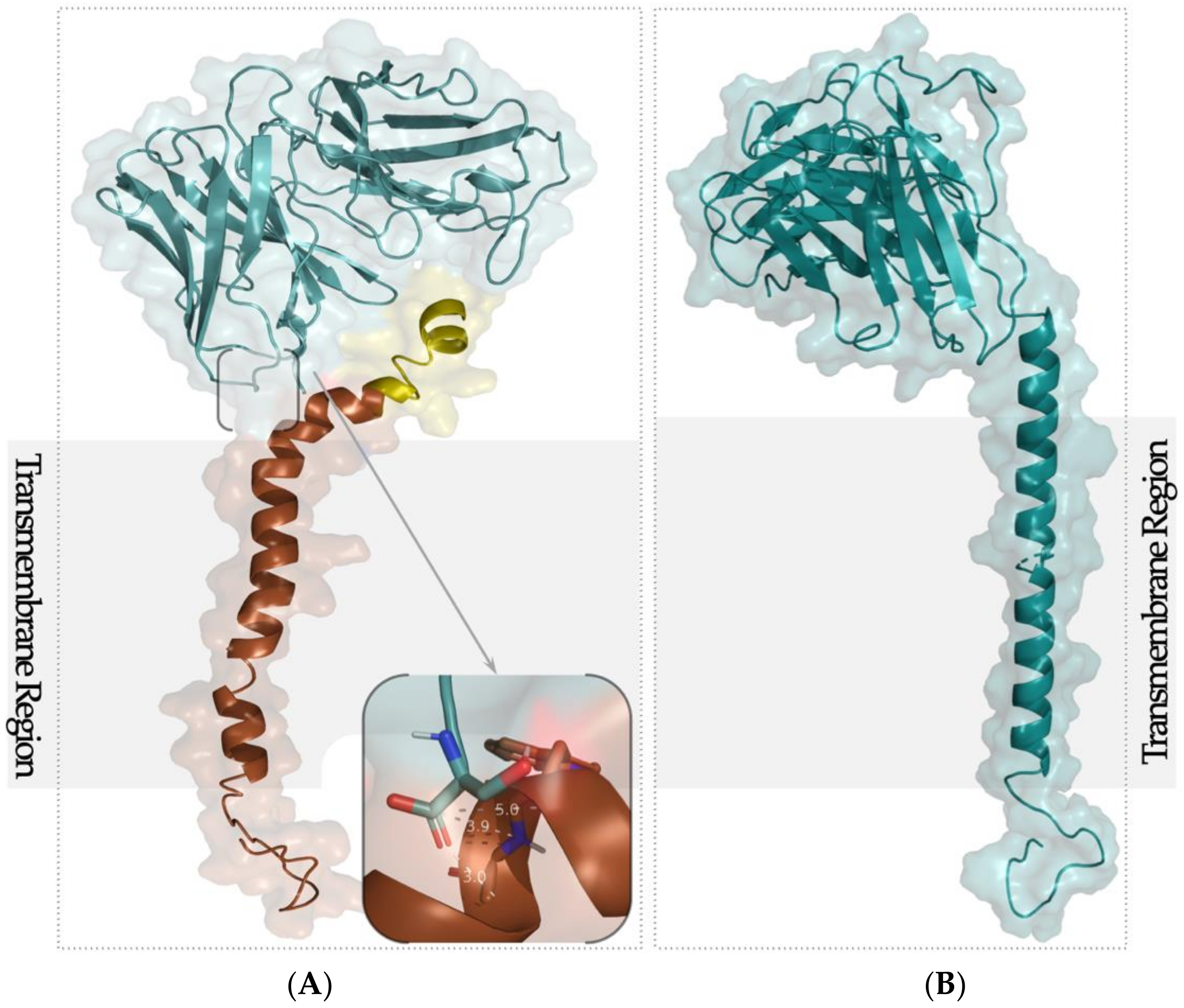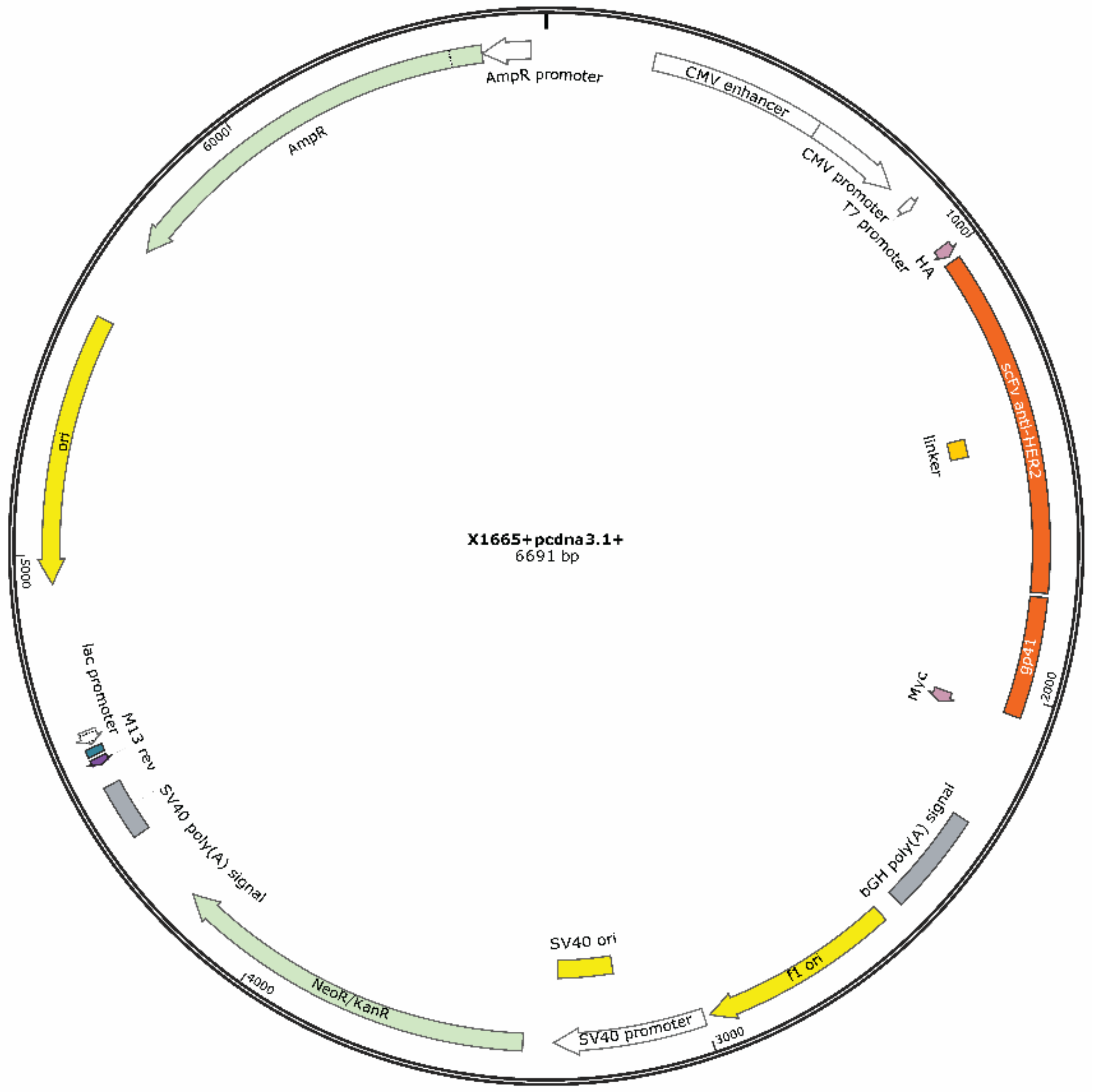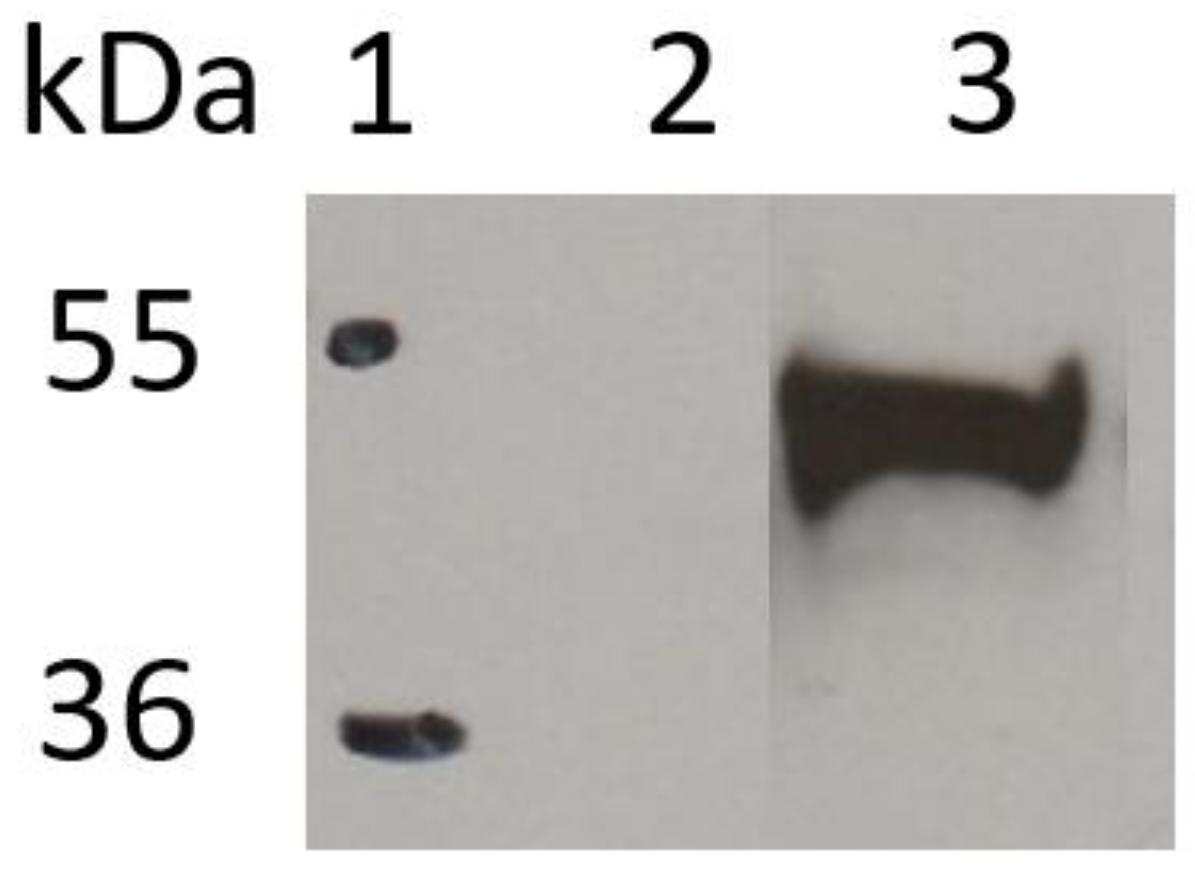Integrated in Silico and Experimental Approach towards the Design of a Novel Recombinant Protein Containing an Anti-HER2 scFv
Abstract
1. Introduction
2. Results
2.1. Docking Simulation
2.2. Vector Design and Assessment of the Recombinant Protein Expression
3. Materials and Methods
3.1. Molecular Modeling and Docking Simulation
3.2. Plasmid DNA Construction and Transformation of Escherichia coli
3.3. Cell Culture and Transfection
3.4. Western Blot
4. Conclusions
Author Contributions
Funding
Institutional Review Board Statement
Informed Consent Statement
Conflicts of Interest
References
- Iqbal, N.; Iqbal, N. Human Epidermal Growth Factor Receptor 2 (HER2) in Cancers: Overexpression and Therapeutic Implications. Mol. Biol. Int. 2014. [Google Scholar] [CrossRef] [PubMed]
- Roskoski, R. The ErbB/HER Family of Protein-Tyrosine Kinases and Cancer. Pharmacol. Res. 2014, 79, 34–74. [Google Scholar] [CrossRef] [PubMed]
- Holliger, P.; Hudson, P.J. Engineered Antibody Fragments and the Rise of Single Domains. Nat. Biotechnol. 2005, 23, 1126–1136. [Google Scholar] [CrossRef]
- Monnier, P.; Vigouroux, R.; Tassew, N. In Vivo Applications of Single Chain Fv (Variable Domain) (ScFv) Fragments. Antibodies 2013, 2, 193–208. [Google Scholar] [CrossRef]
- Gulati, N.M.; Stewart, P.L.; Steinmetz, N.F. Bioinspired Shielding Strategies for Nanoparticle Drug Delivery Applications. Mol. Pharm. 2018, 15, 2900–2909. [Google Scholar] [CrossRef] [PubMed]
- Steinmetz, N.F. Viral Nanoparticles as Platforms for Next-Generation Therapeutics and Imaging Devices. Nanomed. Nanotechnol. Biol. Med. 2010, 6, 634–641. [Google Scholar] [CrossRef] [PubMed]
- Watkins, J.; Marsh, A.; Taylor, P.C.; Singer, D.R.J. Personalized Medicine: The Impact on Chemistry. Ther. Deliv. 2010, 1, 651–665. [Google Scholar] [CrossRef] [PubMed]
- Caravella, J.; Lugovskoy, A. Design of Next-Generation Protein Therapeutics. Curr. Opin. Chem. Biol. 2010, 14, 520–528. [Google Scholar] [CrossRef]
- Rosano, G.L.; Ceccarelli, E.A. Recombinant Protein Expression in Escherichia Coli: Advances and Challenges. Front. Microbiol. 2014, 5. [Google Scholar] [CrossRef] [PubMed]
- Zou, Q.; He, W. Special Protein Molecules Computational Identification. Int. J. Mol. Sci. 2018, 19, 536. [Google Scholar]
- Garcea, R.L.; Gissmann, L. Virus-like Particles as Vaccines and Vessels for the Delivery of Small Molecules. Curr. Opin. Biotechnol. 2004, 15, 513–517. [Google Scholar] [CrossRef] [PubMed]
- Chen, C.W.; Saubi, N.; Joseph-Munné, J. Design Concepts of Virus-Like Particle-Based HIV-1 Vaccines. Front. Immunol. 2020, 11, 573157. [Google Scholar] [CrossRef] [PubMed]
- Dominguez, C.; Boelens, R.; Bonvin, A.M.J.J. HADDOCK: A Protein-Protein Docking Approach Based on Biochemical or Biophysical Information. J. Am. Chem. Soc. 2003, 125, 1731–1737. [Google Scholar] [CrossRef]
- van Zundert, G.C.P.; Bonvin, A.M.J.J. Modeling Protein–Protein Complexes Using the HADDOCK Webserver “Modeling Protein Complexes with HADDOCK. ” Methods Mol. Biol. 2014, 1137, 163–179. [Google Scholar] [CrossRef] [PubMed]
- Dana, H.; Mahmoodi Chalbatani, G.; Gharagouzloo, E.; Miri, S.R.; Memari, F.; Rasoolzadeh, R.; Zinatizadeh, M.R.; Kheirandish Zarandi, P.; Marmari, V. In Silico Analysis, Molecular Docking, Molecular Dynamic, Cloning, Expression and Purification of Chimeric Protein in Colorectal Cancer Treatment. Drug Des. Devel. Ther. 2020, 14, 309–329. [Google Scholar] [CrossRef] [PubMed]
- Dehghanian, F.; Kay, M.; Kahrizi, D. A Novel Recombinant AzrC Protein Proposed by Molecular Docking and in Silico Analyses to Improve Azo Dye’s Binding Affinity. Gene 2015, 569, 233–238. [Google Scholar] [CrossRef]
- Buzon, V.; Natrajan, G.; Schibli, D.; Campelo, F.; Kozlov, M.M.; Weissenhorn, W. Crystal Structure of HIV-1 Gp41 Including Both Fusion Peptide and Membrane Proximal External Regions. PLoS Pathog. 2010, 6, 1–7. [Google Scholar] [CrossRef]
- Apellániz, B.; Rujas, E.; Serrano, S.; Morante, K.; Tsumoto, K.; Caaveiro, J.M.M.; Jiménez, M.Á.; Nieva, J.L. The Atomic Structure of the HIV-1 Gp41 Transmembrane Domain and Its Connection to the Immunogenic Membrane-Proximal External Region. J. Biol. Chem. 2015, 290, 12999–13015. [Google Scholar] [CrossRef] [PubMed]
- Šali, A.; Blundell, T.L. Comparative Protein Modelling by Satisfaction of Spatial Restraints. J. Mol. Biol. 1993, 234, 779–815. [Google Scholar] [CrossRef] [PubMed]
- Yu, C.-M.; Peng, H.-P.; Chen, I.-C.; Lee, Y.-C.; Chen, J.-B.; Tsai, K.-C.; Chen, C.-T.; Chang, J.-Y.; Yang, E.-W.; Hsu, P.-C.; et al. Rationalization and Design of the Complementarity Determining Region Sequences in an Antibody-Antigen Recognition Interface. PLoS ONE 2012, 7, e33340. [Google Scholar] [CrossRef] [PubMed]
- Ganugapati, J.; Akash, S. Multi-Template Homology Based Structure Prediction and Molecular Docking Studies of Protein ‘L’ of Zaire Ebolavirus (EBOV). Inform. Med. Unlocked 2017, 9, 68–75. [Google Scholar] [CrossRef]
- Shen, M.; Sali, A. Statistical Potential for Assessment and Prediction of Protein Structures. Protein Sci. 2006, 15, 2507–2524. [Google Scholar] [CrossRef] [PubMed]
- Eswar, N.; Webb, B.; Marti-Renom, M.A.; Madhusudhan, M.S.; Eramian, D.; Shen, M.; Pieper, U.; Sali, A. Comparative Protein Structure Modeling Using Modeller. Curr. Protoc. Bioinform. 2006, 15, 5–6. [Google Scholar] [CrossRef] [PubMed]
- Grant, B.J.; Rodrigues, A.P.C.; ElSawy, K.M.; McCammon, J.A.; Caves, L.S.D. Bio3d: An R Package for the Comparative Analysis of Protein Structures. Bioinformatics 2006, 22, 2695–2696. [Google Scholar] [CrossRef] [PubMed]
- Lessard, J.C. Transformation of E. coli via electroporation. In Methods in Enzymology; Academic Press Inc.: Cambridge, MA, USA, 2013; Volume 529, pp. 321–327. ISBN 9780124186873. [Google Scholar]
- Rueden, C.T.; Schindelin, J.; Hiner, M.C.; DeZonia, B.E.; Walter, A.E.; Arena, E.T.; Eliceiri, K.W. ImageJ2: ImageJ for the next Generation of Scientific Image Data. BMC Bioinform. 2017, 18, 529. [Google Scholar] [CrossRef] [PubMed]



Publisher’s Note: MDPI stays neutral with regard to jurisdictional claims in published maps and institutional affiliations. |
© 2021 by the authors. Licensee MDPI, Basel, Switzerland. This article is an open access article distributed under the terms and conditions of the Creative Commons Attribution (CC BY) license (http://creativecommons.org/licenses/by/4.0/).
Share and Cite
Santos, J.; Cardoso, M.; Moreira, I.S.; Gonçalves, J.; Correia, J.D.G.; Verde, S.C.; Melo, R. Integrated in Silico and Experimental Approach towards the Design of a Novel Recombinant Protein Containing an Anti-HER2 scFv. Int. J. Mol. Sci. 2021, 22, 3547. https://doi.org/10.3390/ijms22073547
Santos J, Cardoso M, Moreira IS, Gonçalves J, Correia JDG, Verde SC, Melo R. Integrated in Silico and Experimental Approach towards the Design of a Novel Recombinant Protein Containing an Anti-HER2 scFv. International Journal of Molecular Sciences. 2021; 22(7):3547. https://doi.org/10.3390/ijms22073547
Chicago/Turabian StyleSantos, Joana, Miguel Cardoso, Irina S. Moreira, João Gonçalves, João D. G. Correia, Sandra Cabo Verde, and Rita Melo. 2021. "Integrated in Silico and Experimental Approach towards the Design of a Novel Recombinant Protein Containing an Anti-HER2 scFv" International Journal of Molecular Sciences 22, no. 7: 3547. https://doi.org/10.3390/ijms22073547
APA StyleSantos, J., Cardoso, M., Moreira, I. S., Gonçalves, J., Correia, J. D. G., Verde, S. C., & Melo, R. (2021). Integrated in Silico and Experimental Approach towards the Design of a Novel Recombinant Protein Containing an Anti-HER2 scFv. International Journal of Molecular Sciences, 22(7), 3547. https://doi.org/10.3390/ijms22073547










